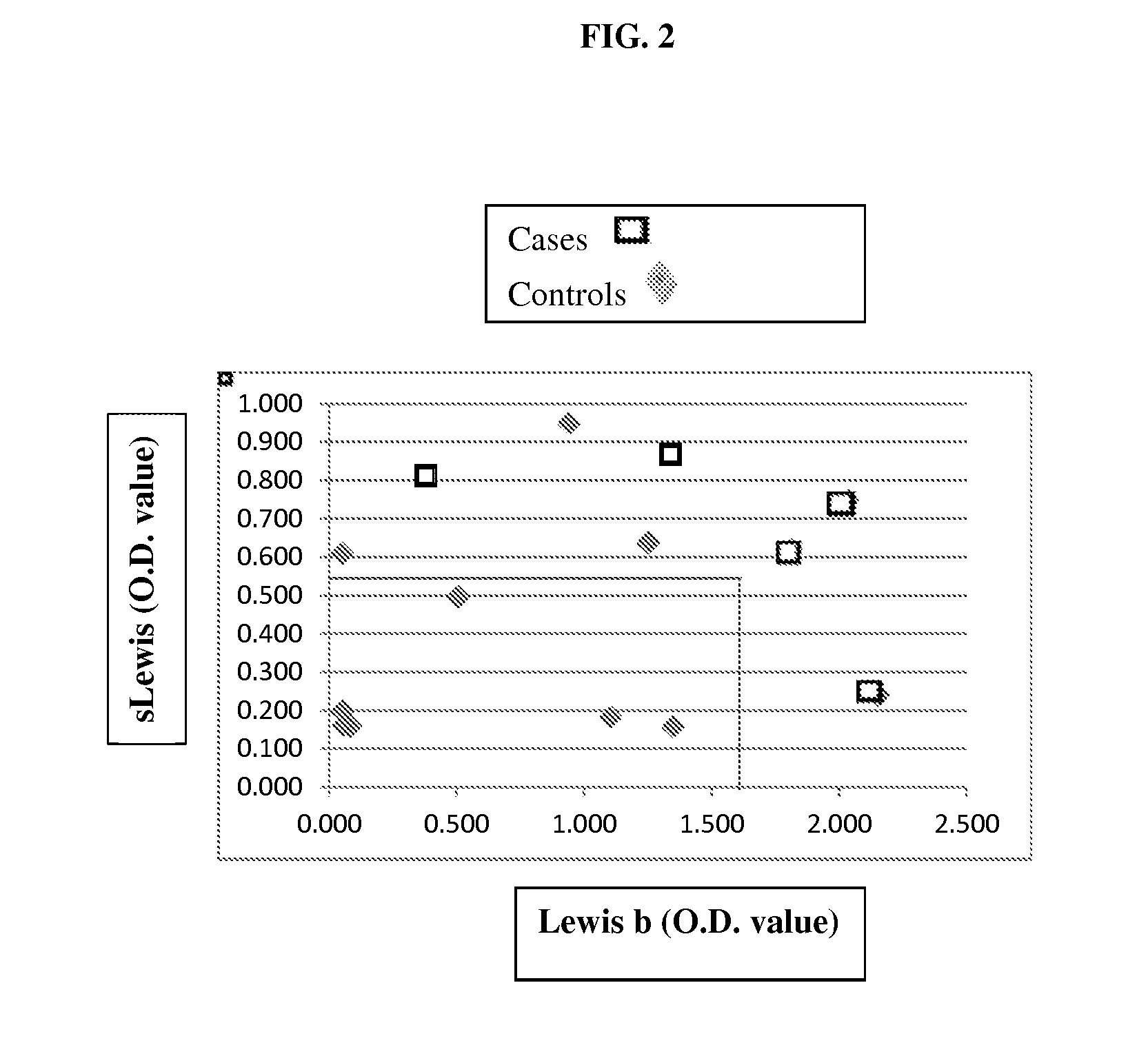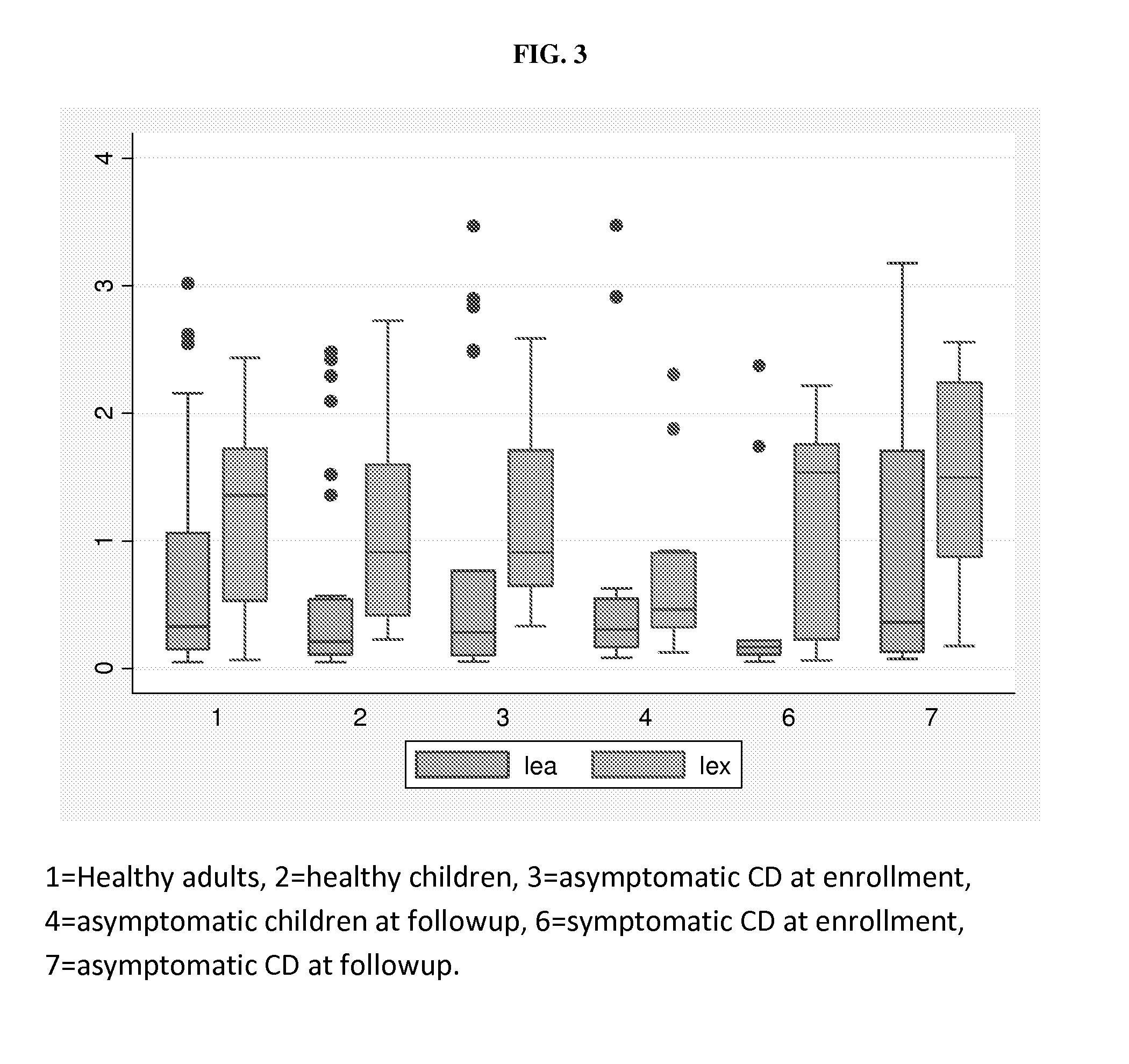Use of glycans and glycosyltransferases for diagnosing/monitoring inflammatory bowel disease
- Summary
- Abstract
- Description
- Claims
- Application Information
AI Technical Summary
Benefits of technology
Problems solved by technology
Method used
Image
Examples
example 1
Identification of Glycosyltransferases Differentially Expressed in Patients with IBD
[0100]RNA samples were prepared from colon biopsies of affected segments of CD and UC patients and healthy controls, and the global patterns of gene expression were examined using the HGU133 Plus V.2 Affymetrix GeneChip in the Cincinnati Children's Digestive Health Center Microarray core.
[0101]As shown in Table 1, ST3Gal IV was found to be significantly (p<0.01) overexpressed in IBD patients versus controls. ST3Gal III and the fucosyltransferase genes, FUT2, FUT3, FUT5 and FUT7 were found to be significantly under-expressed (p<0.05) in IBD patients versus controls. The above results indicate that the expression level of any of these enzymes, or any combination thereof, can be used as a marker for diagnosing IBD or monitoring disease progress.
TABLE 1Intestinal epithelial cell expression of fucosyltransferasegenes and sialyltransferase genes from colon biopsyST3GalST3GalGene expressionFUT2FUT3FUT5FUT7I...
example 2
Identification of Histo-Blood Group Antigens Differentially Expressed in Patients with IBD
[0102]Saliva specimens were tested for secretor and Lewis types by monoclonal antibody based phenotyping methods as previously described. See Huang et al., J Infect Dis 2003; 188; 19-31. Briefly, boiled saliva samples were coated on microtiter plates (Dynex, Immulon; Dynatech, Franklin, Mass.) and then interacted with monoclonal antibodies specific to individual human blood group antigens. The bound antibodies were then detected by corresponding secondary antibody-horseradish peroxidase (HRP) conjugates followed by adding HRP substrate reagents (optEIA, BD Bioscience, San Diego, Calif.).
[0103]As shown in FIG. 1 and Table 2, the level of sialyl Lewis (sLewis) antigens, which refers to the average of sLex and sLea levels, was found to be significantly higher in IBD patients (i.e., cases) as relative to the controls.
TABLE 2Optical density (OD) values for sialyl Lewis in patientswith Crohn's Diseas...
example 3
Salivary Glycan Biomarkers for Monitoring Crohn's Patients
[0105]The goal of this study was to study salivary glycans (histo-blood group antigens) as biomarkers of symptom flares in Crohn's Disease by examining the levels of these antigens in the saliva samples of symptomatic Crohn's disease patients, compared to asymptomatic Crohn's Disease patients and healthy controls. For the symptomatic and asymptomatic Crohn's Disease patients, a stool sample was also collected after the clinic visit, which was tested for fecal biomarkers. A second saliva sample was collected from the patient concurrent with the stool sample collection. It was determined that the primary candidate biomarker was sialyl Lewis x, as it was found to be elevated in symptomatic patients.
[0106]It was found that salivary levels of sialyl Lewis x antigen (and Lewis x antigen) were elevated in symptomatic Crohn's patients compared to the asymptomatic Crohn's patients in the second saliva collection. There was no associat...
PUM
| Property | Measurement | Unit |
|---|---|---|
| Level | aaaaa | aaaaa |
Abstract
Description
Claims
Application Information
 Login to View More
Login to View More - R&D
- Intellectual Property
- Life Sciences
- Materials
- Tech Scout
- Unparalleled Data Quality
- Higher Quality Content
- 60% Fewer Hallucinations
Browse by: Latest US Patents, China's latest patents, Technical Efficacy Thesaurus, Application Domain, Technology Topic, Popular Technical Reports.
© 2025 PatSnap. All rights reserved.Legal|Privacy policy|Modern Slavery Act Transparency Statement|Sitemap|About US| Contact US: help@patsnap.com



